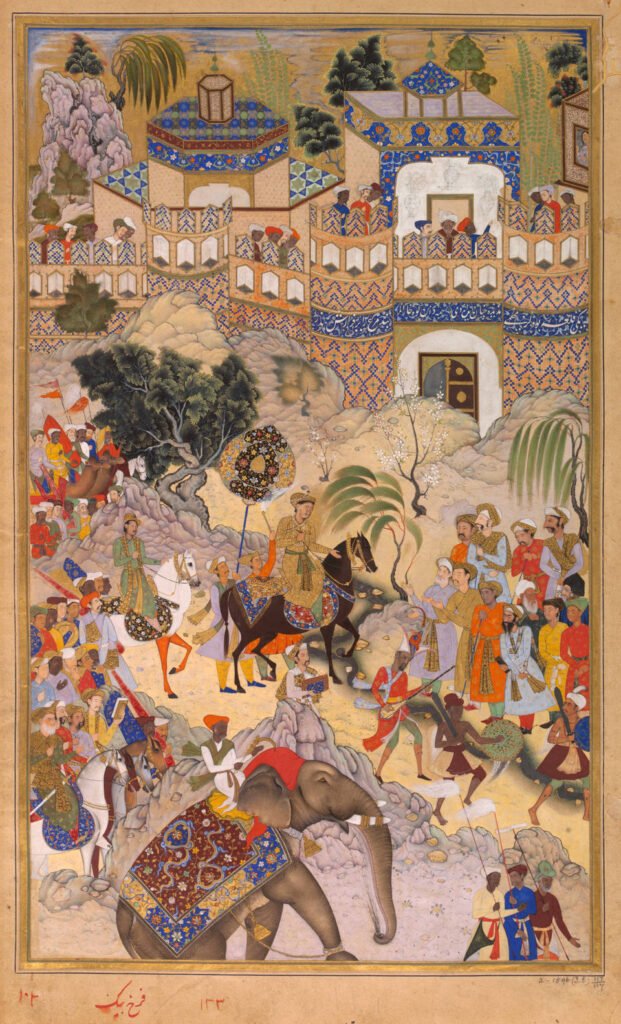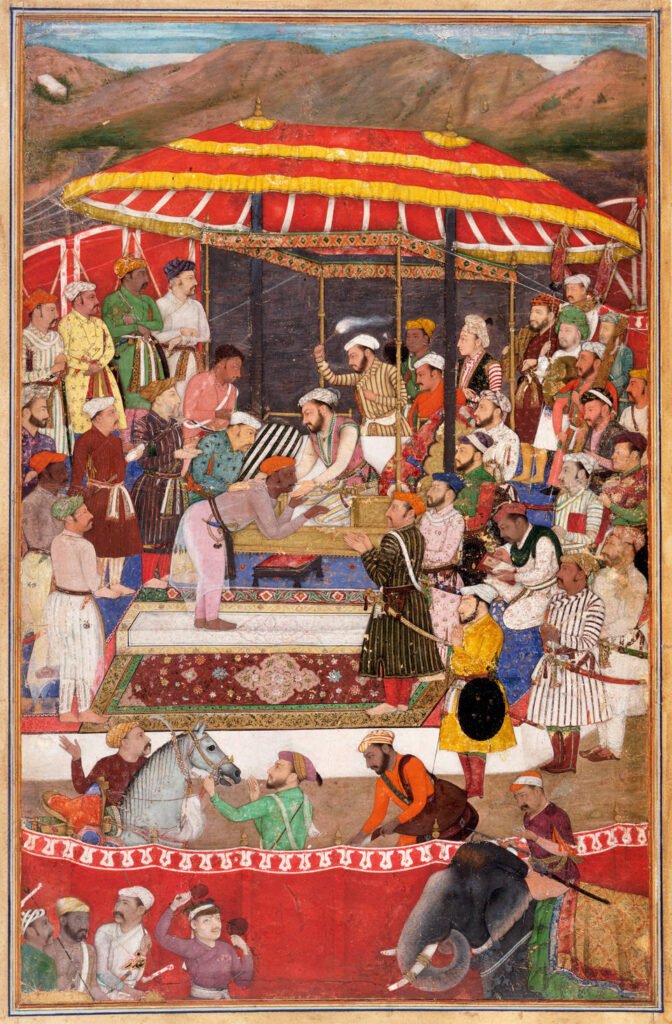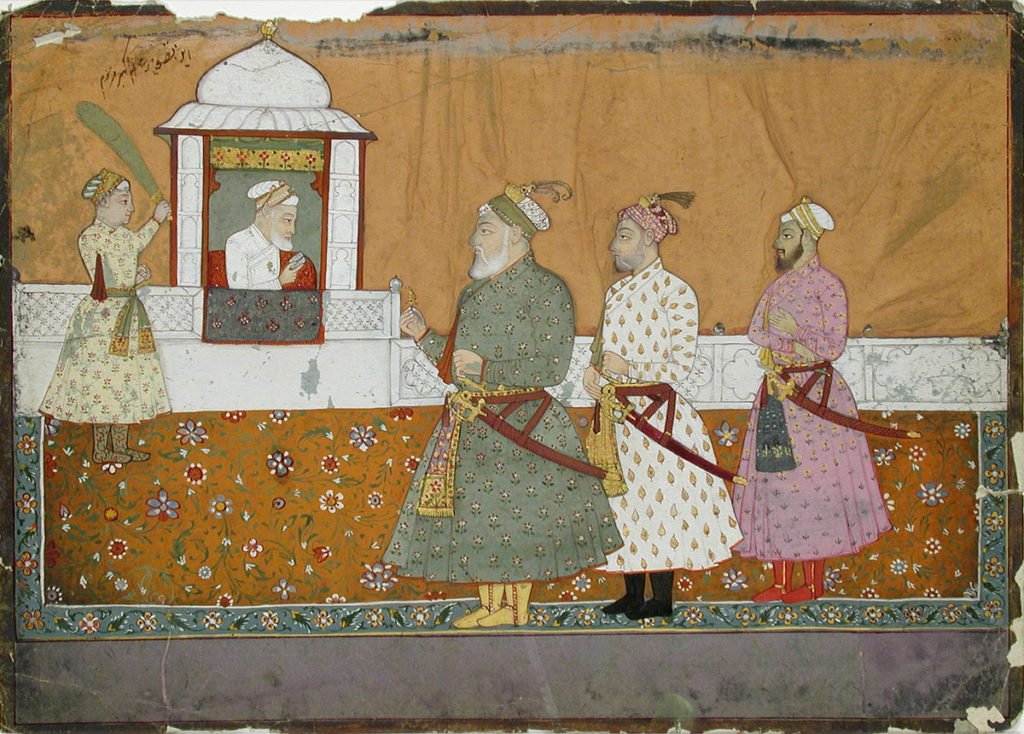Mughal paintings are a type of miniature painting where Mughal artists create intricate miniature paintings. From the sixteenth to the eighteenth centuries, they evolved under the Mughal Empire. The Mughals supported literature, art, and building. Mughal monarchs introduced the practice of miniature painting in their courts. European, Indian, and Persian artistic influences were blend together in the creation of Mughal paintings. Their color brightness, delicate workmanship, and blending of several artistic traditions have earned them recognition. Under Akbar and Jahangir, miniature painting reached its pinnacle of creativity.
History & Origin of Mughal Paintings
- Before the Mughal Empire rose to power, the Delhi Sultanate ruled over the majority of the Indian subcontinent.
- Since the tenth century, miniature painting has been evolving worldwide, and it reached its pinnacle at several provincial courts around the Sultanate of Delhi.
- Upon his return from exile, Mir Sayyid Ali and Abd al-Samad, two well-known Persian artists, accompanied the second Mughal emperor Humayun.
- Following Humayun’s instructions, these Persian artists produced a number of well-known paintings, most notably the “Khamsa of Nizami.”
- Due of these paintings’ departure from conventional Persian art, a brand-new genre known as “Mughal Painting” emerged. The Mughal artworks were enhance by later Mughal emperors.
- The earliest example of Mughal painting is the Tutinama (‘Tales of a Parrot’) painting.
Art Trend under Akbar Reign

Akbar’s triumphant entry into Surat, detached folio from a copy of the Akbarnama, opaque watercolour and gold on paper, by Farrukh Beg, 1590 – 95, Mughal. Museum no. IS.2:117-1896. © Victoria and Albert Museum, London
In the third book of his literature, Ain-e Akbari (The Regulations, or Institutes of Akbar), the Ketabkhana is list among the numerous departments of the royal household, together with a list of the most prominent painters of the day.
Several of their names can be found on paintings that go with an unfinish, unbound Akbarnama text that the South Kensington Museum purchases in 1896. These show that the manuscript’s initial purpose was to serve as the emperor’s presentation copy. A contemporary librarian identified all 116 paintings in the book, which spans the years 1560 to 1577, and gave credit to their respective creators. Beneath each illustration are these inscriptions, written in red ink, indicating that one person planned the composition (tarh), and that another, maybe junior, artist was accountable for carrying out the “work” (‘amal,’ adding color to this outline). Sometimes the responsibility of painting the features of the major characters in the scene fell to a specialized portraitist.
Paintings from the Akbarnama and Harivamsa reveal contact with Western art, another important formative influence in the evolution of Mughal art. Some paintings in the Akbarnama deviate from the scientific perspective but evoke a sense of depth reminiscent of European art.
Art Trend under Jahangir Reign

Prince Khurram receiving the submission of the Rana of Mewar in 1614, opaque watercolour and gold on paper, by Nanha, about 1615 – 18, Mughal. Museum no. IS.185-1984. © Victoria and Albert Museum, London
Jahangir had a keen interest in the arts as well, and Mughal painting flourished under his rule. He give his painters the instruction to employ a single-point perspective since he was influence by European painting. Jahangir’s Mughal paintings therefore tended to have warmer hues and more delicate brushwork. Additionally, Jahangir’s artists started experimenting with novel methods, like the application of shadow and shade.
Art Trend under Shah Jahan Reign

Shah Jahan riding with one of his sons, watercolour, painted by Manohar in about 1615, alterations by Murar in about 1630, Mughal. Museum no. IM.12-1925. © Victoria and Albert Museum, London
Shah Jahan had many paintings commissioned for his personal library. Among the themes that influenced these works were gardens and flowers. One of the most important books, “Padshahnama,” was written during his reign. It was a sumptuous book that enumerated the monarch’s accomplishments. The hallmarks of Shah Jahan’s painting technique were the use of vibrant colors and painstaking attention to detail.
Art Trend under Aurangzeb Reign

Aurangzeb in a Pavilion with Courtiers below, ca. 1720, Deccan, India. © San Diego Museum of Art, CA, USA.
Paintings of any kind were not encourage have or support by Aurangzeb.
Nonetheless, he oversaw the production of some of the greatest works of Mughal art. Experience of artists who knew Aurangzeb would soon order the workshops to be closed create these paintings.
The use of vivid colors and the accurate depiction of people and events in these paintings were their defining features.
Process of Mughal Paintings
- Most of the miniature paintings that we see now are products of Mughal manuscripts and royal albums, where images and words were combine in a predetermine arrangement.
- These book paintings were made by following a particular process.
- Firstly, handmade paper sheets were carefully prepare and cut to fit the size of the document.
- The artist was given a specific area to work in while creating a suitable visual composition. The pages were then rule and loade with text.
- The artist received the text to be translated into a more concise visual representation after it was written down.
- The artist set out on a voyage that involve several phases, starting with the composition (called “tarh”), then portraiture (“chiharanama”), and finally coming to a head when colors are applied (“rangamizi”).
Techniques and Colours Used in Mughal Paintings
- The Mughal atelier used highly adept painters and colorists.
- Mughal paintings were create using handmade paper prepare specifically for that purpose.
- They grounded and combined the pigments to create exact tones of the opaque hues, derived from natural materials.
- We applied the paint with brushes having squirrel or kitten fur coverings.
- Painting in a workshop setting involved a group of artists working together to complete tasks including basic draft drawing, color grinding, filling, and adding details.
- Still, it’s possible that a single artist produced some of the works.
- Early Mughal paintings were the product of collaborative effort, with each artist focusing on a distinct area of the painting according to their level of comfort and skill.
- Artists were given incentives and pay raises in accordance with their contributions to the job.
- The recorded names indicate the positions and status of master artists within the royal atelier.
- They used an agate gemstone to burnish the painting after it was finished, setting the colors and enhancing its brilliance.
- Natural sources provided a variety of pigments and hues, such as cinnabar for vermilion, Lapiz Lazuli for ultramarine, orpiment for bright yellow, shells for white, and charcoal for lampblack.
- To enhance luxury, gold and silver powders were added to paints or blended with colors.
Conclusion
The Mughal art, on the other hand, had left an indelible impression and had spread to a number of local courts. The great age of Mughal art lasted from about 1580 to 1650 and spanned the reigns of three emperors: Akbar, Jahangir and Shah Jahan. Hindu and Muslim artists and craftsmen from the northern regions of the Indian subcontinent worked with Iranian masters in the masculine environment of the royal workshops. A radically new and rapidly evolving style of art for the court was produced by combining their very different traditions.



